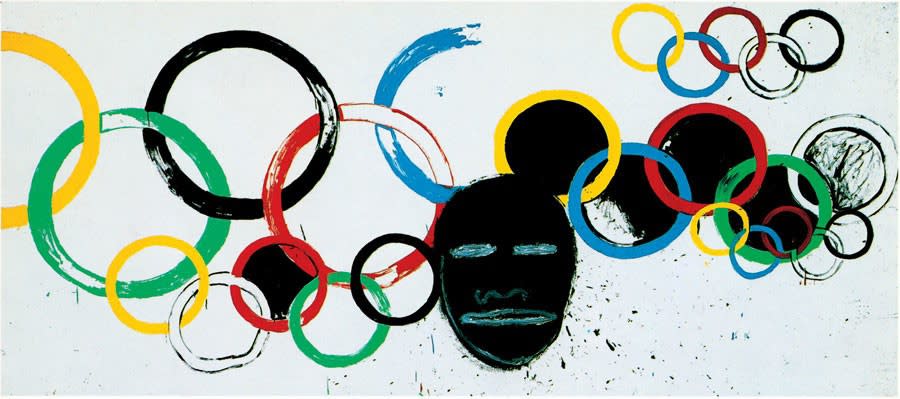
"Olympics" is a painting created by American artists Jean-Michel Basquiat and Andy Warhol in 1984. The artwork was crafted to commemorate the 1984 Summer Olympics held in Los Angeles, and symbolises the timeless nature of human achievement, encapsulating both sporting and artistic immortality using the iconic five rings of the Olympics as its central motif.
In June 2012, the painting sold for $10.5 million at Phillips's Contemporary Art Evening Sale, setting a record high for a Warhol-Basquiat collaboration at that time. It stands as the second most expensive Warhol-Basquiat collaboration ever sold at auction, only surpassed by "Zenith" (1985).
Despite a relative decline in popularity by the late 1970s, Warhol experienced a resurgence in the 1980s, partly due to his connections with prolific younger artists who were reshaping the New York art scene. Such artists included Keith Haring, Kenny Schard and, of course, Jean-Michel Basquiat amongst others.
Basquiat idolised Warhol and was thrilled when he sold him a postcard in 1979 - reportedly one of the first works sold by the artist. It wouldn’t be until October 1982, when they were formally introduced by Swiss art dealer Bruno Bischofberger, that the two distinct artist’s worlds would begin to intersect. By then, Basquiat had become a neo-expressionist sensation going from unknown artist to dominating the cultural and artistic discourse at the time in a matter of months. With a blossoming artistic and personal relationship, the two began to collaborate on a series of works.
Exploring themes of identity and society, the two distinct artists explored identity, society, and the intersection between art and popular culture. Basquiat's raw and expressive works confronting issues of racial identity, social inequality, and urban life, while Warhol's iconic portraits and consumerist imagery reflected a mass-media saturated society. Through the collaboration, the two invited viewers to contemplate the artists' shared fascination with cultural icons, commodification, and the power dynamics of the art world.
Their partnership was not without tension. By September 1985, their joint exhibit "Warhol and Basquiat: Paintings" at the Tony Shafrazi Gallery in SoHo received mostly negative reviews, straining their relationship. Basquiat was particularly hurt by being labelled as Warhol's accessory. Warhol's death following gallbladder surgery in 1987 deeply affected Basquiat, who succumbed to grief and guilt, and died the following year from a heroin overdose.
According to the Olympic Charter, Rule 8, “The Olympic symbol expresses the activity of the Olympic Movement and represents the union of the five continents and the meeting of athletes from throughout the world at the Olympic Games.” Indeed, tis union of athletic accomplishments was mirrored by Warhol and Basquiat’s collaborative approach to creating art together.
In their collaborations, Warhol typically initiated the process with a concrete or recognisable element, such as a newspaper headline or product logo, which Basquiat would then modify with his distinctive animated style. For "Olympics," Warhol painted the five-ring Olympic symbols in primary colours, while Basquiat added his signature heads over them.
"Olympics" represents more than just a commemoration of the 1984 Summer Olympics; it is a testament to the enduring legacy of human creativity and achievement. Through their collaborative art, Warhol and Basquiat immortalised their distinct yet complementary visions, leaving an indelible mark on the world of contemporary art. Their partnership highlights the power of collaboration in achieving artistic immortality, paralleling the way athletes achieve immortality through their sporting feats.
Discover original Andy Warhol art for sale or to buy original Warhol prints and contact Andipa via sales@andipa.com or call +44 (0)20 7581 1244 for further information.